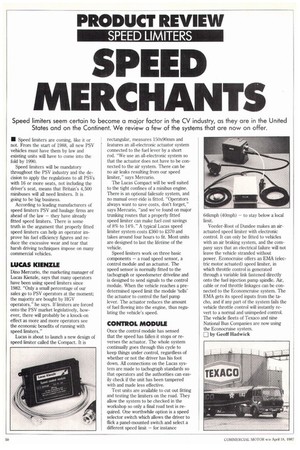SP
Page 52

If you've noticed an error in this article please click here to report it so we can fix it.
ED
MERCHANTS
Speed limiters seem certain to become a major factor in the CV industry, as they are in the United States and on the Continent. We review a few of the systems that are now on offer.
• Speed limiters are coming, like it or not. From the start of 1988, all new PSV vehicles must have them by law and existing units will have to come into the fold by 1990.
Speed limiters will be mandatory throughout the PSV industry and the decision to apply the regulations to all PSVs with 16 or more seats, not including the driver's seat, means that Britain's 4,500 minibuses will all need limiters. It is going to be big business.
According to leading manufacturers of speed limiters PSV and haulage firms are ahead of the law — they have already fitted speed limiters. There is some truth in the argument that properly fitted speed limiters can help an operator improve his fuel efficiency figures and reduce the excessive wear and tear that harsh driving techniques impose on many commercial vehicles.
LUCAS KIENZLE
Dino Mercurio, the marketing manager of Lucas Kienzle, says that many operators have been using speed limiters since 1982. Only a small percentage of our sales go to PSV operators at the moment; the majority are bought by HGV operators," he says. If limiters are forced onto the PSV market legislatively, however, there will probably be a knock-on effect as more and more operators see the economic benefits of running with speed limiters."
Lucas is about to launch a new design of speed limiter called the Compact. It is rectangular, measures 150x9Omm and features an all-electronic actuator system connected to the fuel lever by a short rod. "We use an all-electronic system so that the actuator does not have to be connected to the air system. There can be no air leaks resulting from our speed limiter," says Mercurio.
The Lucas Compact will be well suited to the tight confines of a minibus engine. There is an optional failesafe system, and no manual over-ride is fitted. "Operators always want to save costs, don't forget," says Mercurio, "and we've found on major trwiking routes that a properly fitted speed limiter can make fuel cost savings of 8% to 14%." A typical Lucas speed limiter system costs 060 to £370 and takes around four hours to fit. Most units are designed to last the lifetime of the vehicle.
Speed limiters work on three basic components — a road speed sensor, a control module and an actuator. The speed sensor is normally fitted to the tachograph or speedometer driveline and is designed to send signals to the control module. When the vehicle reaches a predetermined speed limit the module 'tells' the actuator to control the fuel pump lever. The actuator reduces the amount of fuel flowing into the engine, thus regulating the vehicle's speed.
CONTROL MODULE
Once the control module has sensed that the speed has fallen it stops or reverses the actuator. The whole system continually goes through this cycle to keep things under control, regardless of whether or not the driver has his foot down. All connections on the Lucas system are made to tachograph standards so that operators and the authorities can easily check if the unit has been tampered with and made less effective.
Test units are available to cut out fitting and testing the limiters on the road. They allow the system to be checked in the workshop so only a final road test is required. One worthwhile option is a speed selector switch which allows the driver to flick a panel-mounted switch and select a different speed limit — for instance 64kmph (40mph) — to stay below a local limit.
Veeder-Root of Dundee makes an airactuated speed limiter with electronic control. It can only be fitted to vehicles with an air braking system, and the company says that an electrical failure will not leave the vehicle stranded without power. Econocruise offers an EMA (electric motor actuated) speed limiter, in which throttle control is generated through a variable link fastened directly onto the fuel injection pump spindle. Air, cable or rod throttle linkages can be connected to the Econorncruise system. The EMA gets its speed inputs from the tacho, and if any part of the system fails the vehicle throttle control will instantly revert to a normal and unimpeded control The vehicle fleets of Texaco and nine National Bus Companies are now using the Econocruise system.
0 by Geoff Hadwick




















































































